Plein air painting 09
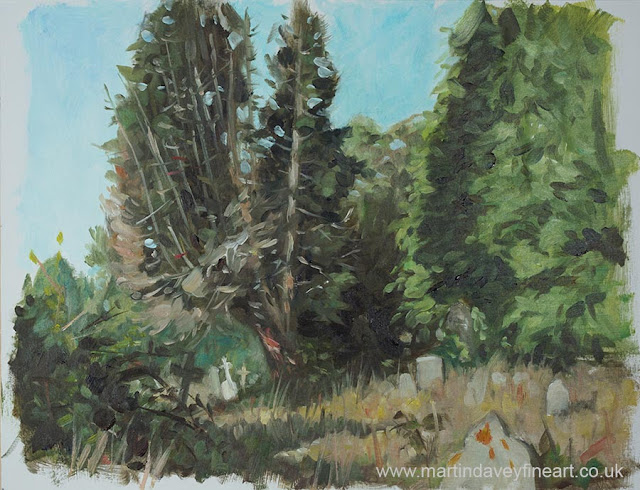 | ||||||||
| old cemetery Southampton on a sunny sunday sketch | |
This is the Blog of artwork by Martin Davey. The artwork is a mixture of digital illustrations created in Photoshop, and paintings created on canvas using oil and acrylic paint media. The entries give some idea of the dates of completion, and influences and inspirations if any. The work is not listed in any particular order or time frame though generally the more recent work is at the start of the blog. My two main websites are www.martindaveyfineart.co.uk, and www.martindaveyillustration.co.uk.
 | ||||||||
| old cemetery Southampton on a sunny sunday sketch | |
 |
| Completed oil painting of the Hampshire common. |
A view of Southampton common in Autumn is the subject of this painting, created during July 2020. Two teenagers are shown strolling along a tarmac path within a wooded area of the common, surrounded by the densely packed trees on either side. The painting measures 20” x 16” and is painted in oils on primed mounting board. It was glazed with a further oil layer when dry to help emphasize the rich colours.
The common itself is of a large area (365 acres) and was first established during the 13th century. It contains varied landscapes from forest areas to grass fields, lakes and play areas
This landscape painting was created during summer 2020 and features Southampton common, a large natural area of special biological interest within the city itself. It is 365 acres in size and contains woodland, grassland and various amenities for the public. The painting, done in oils, is painted on prepared mounting board sized at 20” x 16”.
By following this link, the landscape artwork can be seen in better clarity.
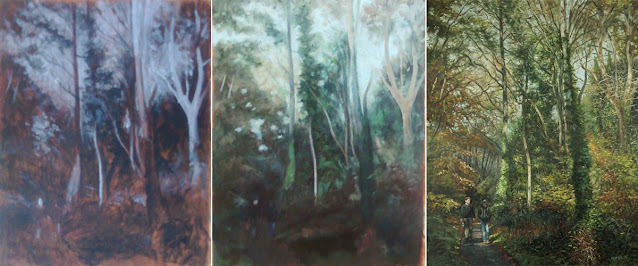 |
| Stages in the creation of the Hampshire common painting. |
The image, split in to 3 panels, shows three stages of the creation of the artwork. In the first panel can be seen the initial drawing done in brown acrylic on on a brown acrylic wash. Certain areas which will be quite light in tone (such as the sky) have been painted with white acrylic paint. Moving on to a later stage the second panel shows initial work on the first oil painted layer, where basic areas of colour are added using thinned oil painting. No detail is done at this stage, is purpose is to act as an underpainting for the scene. When this is dry, in this case 10 days, then work can continue with the final stage, as shown in the 3rd panel. Here in the final stage, paint is added much thicker than before, to the correct colours and with details added, although the underpainting still partially still shows through. Once the painting is completed and dry a 'glazing' layer is added which is a part transparent application of paint held in an oil medium over the painting which is used to emphasize colours and depth in the scene.
The painting can be seen in greater detail on this link.
 |
| View of Watts Park, Southampton |
 |
| Railway painting featuring M7 tank locomotive in the country WIP. |
A steam railway engine is shown running through the southern English countryside in a 1950s setting. The artwork is sized at 22" x 16" and painted in oils on mounting board. It was done for reproduction as a greeting card, sized at 7” x 5”, for a railway society.
The panel above shows three stages of the paintings evolution. In the first panel the drawing, done in dark brown acrylic paint can be seen, which is painted on a brown wash. White paint has been added to indicate tonally lighter areas, such as the sky. Moving on to the second panel a basic set of colours has been added using diluted oil paint. This is done to indicate where the colours and tonal variations are within the artwork, and act as an underpainting. The third and final panel features the finished oil painting. Here the paint has been applied over the underpainting in a thicker and more refined manner, and detail added. This nostalgic railway scene can be seen in better resolution by following this link.
 |
| Painting of locomotive in the countryside, set in the 1950s. |
This post shows a number of faces plucked off the internet and painted for this exercise. Some are famous and some not. The task is just to practice painting faces. They are done on pieces of paper and board sized at 10" x 8", primed, and then done in a period 3 hrs of so, working wet in to wet. The images are not drawn with pencils in a careful way, but drawn with diluted oil paint in a rough manner, and then painted over. Often the proportions are refined as it is painted until it looks reasonably right, in the one sitting. One other important element of these exercises is that they have been done using a limited range of colours, called the Zorn palette. It is named after the Swedish artist, Anders Zorn (18 February 1860 – 22 August 1920). It consists of just 4 colors being yellow ochre, ivory black, Cadmium red and titanium white. These colours suit faces very well, though landscape subjects would not work so well as blues and greens cannot be mixed.
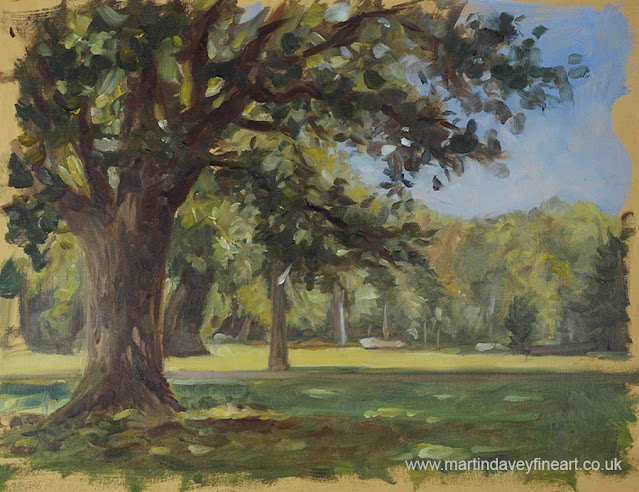 |
| A sunny Southampton common morning plein air art |
 |
| 3 stages of the self portrait WIP |
During 2020 I decided to paint my own self portrait. It is in oils on mounting board, sized at 33” x 23”, or A1. This was my first tackle subject wise at such a project bus as I did not have any other subject it seemed like a good idea. Also the picture could be a good item for an upcoming exhibition.
The picture above shows three stages of the artwork in creation. In the first panel can be seen the initial drawing, done in dark brown acrylic paint. This is done on a wash or 'ground' of lighter brown paint. White acrylic paint has been added to indicate areas of a lighter tone. Once this is done then work can begin on the proper oil painting, as seen in the second panel. Here diluted oil paint has been used to paint over the acrylic layer so as to give an indication of colour and tonal qualities. Not much detail is paid to detail at this time and this layer acts as an underpainting. It will be in turn painted over with heavier brushwork but so of this layer will still show through the paint to the final image. In the last panel can be seen the final painting. Here the paint has been applied thickly and detail painted in. The colours are also more carefully mixed to get to the correct desired opaque colour. There was one other stage done on this layer and that is a glazing paint layer. It is where a small quantity of paint is diluted in a heavy transparent oil, thicker than normal paint oil and painted on top of the normal, previously painted layer. It is similar to coloured stain glass in a way and adds a little extra to the colour, like a layered colour where the light goes through the transparent layer, hits the opaque surface and bounces back through the top layer giving a richer experience to the viewer. Sadly this effect cannot really be captured by a camera so just three stages are shown here..
The self portrait can be viewed in greater detail on this link.
 |
| Completed self portrait of Martin Davey |
Painted in late spring 2020 this self
portrait was done during the period the world was gripped by
Covid-19. At the time of painting the subject was recovering from the
effects himself having caught it at Easter that year. Also the world
was in lock down so he gave up shaving and his hair grew as there were no barbers open!. It was due
to be cut earlier in March, just as the lock down took effect. The subject is shown against a painting of St Pauls cathedral, London, on the easel. That work was done earlier in the year and can be seen on this link. He is holding a wooden kidney shaped palette.
This artwork is painted in oils on a prepared mounting board sized at 23” x 33” approx.
It can be seen in greater detail on this link.
 |
| Plein air art Westgate House with roundabout |
Mayflower roundabout in south Southampton is shown in this plein air art. The old building in the center is Westgate House, a building that originally faced the water before the land in front was reclaimed. It was originally in a different part of the city and was moved in the 1600's to the present location. This is the back side shown in the painting. The large arch gateway was originally a main entrance in to the city from those disembarking from shipping . On the left is the 'Pig in the wall' hotel and the tall spire rising in the background belongs to St Michael's church. Painted on Saturday 5th September on a 12” x 9” board in oil.
 |
| Four panels showing how the painting was built up. |
The oil painting shows two Highland cows by a road in the New Forest, situated in the county of Hampshire. The painting is measures 35.5cm x 20cm and is done on mounting board, primed for oil use.
The picture above shows the creation of the painting in four stages. In the first panel is the drawing, done using brown/ black acrylic paint on a lighter brown base wash. White paint is then added to areas to show where the highlight or tonally brighter areas will be, for instance like the sky.
Once this initial application is done and dried, then the first applications of oil paint are made. The paint is not applied thickly, but thinned with a medium such as turpentine or in this case a paint thinner called 'Zest it' which is a safer chemical made from 'green' materials. This layer gives an indication of the placements of colours and values throughout the scene, but no details are painting at this stage. In the third panel stronger, thicker colours are applied as this is the start of the final painting. Details are added and generally care is taken to paint correctly, while in the fourth and final panel is the finished painting. It should be pointed out that an extra layer has been added which is a coloured 'glaze' applied to some of the elements in the scene. This is used to reinforce colours and add a depth to the painting that only the eye can see. The camera tends to flatten this effect.
The painting can be seen in greater detail by following this link.
 |
| Completed painting of the two bulls |
This scene features two Highland bulls enjoying the sunshine in the countryside. The location is just outside the town of Brockenhurst where a footpath meets Rhinefield Road. This is within the area of the very large New Forest, which can be found in the County of Hampshire on the south coast of the UK. The painting was done during July 2020 and is done in oils on mounting board, sized at 35.5cm x 20cm.
The artwork can be examined in better clarity on this external site.
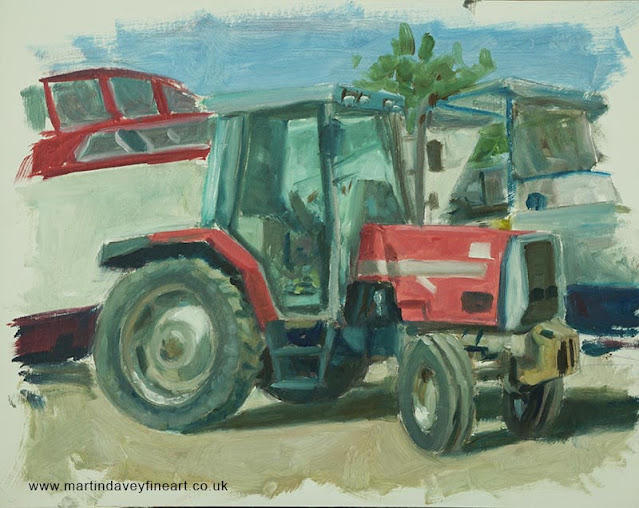 |
| Tractor oil painting sketch |
 |
| Southampton old cemetery headstone pair |
 |
| Comparing the digital rough art to the final oil painting |
I often use digital tools during the creation of my artwork. The amount can vary. For a full digital illustration it follows that the entire art will be created using computer technology, right from the blank canvas, through to the drawing and then the finished work. For original oil paintings created using traditional materials the subject may actually be worked out on a computer too. For instance the original photo reference of a scene may be imported in to photoshop and resized to a canvas (size/ proportions) to find the desired composition. Then elements may be altered within the scene like removing/ adding people, telegraph poles or different skies.
Sometimes a traditional painting may feature a subject that does not exist and so it has to be drawn up from scratch. Such was the case for this painting of the 'Mayflower' ship during rough seas in the North Atlantic, set during 1620. I did quite a lot of research in to what the ship looked like as apparently no-one actually knows. This means that the full size replicas built are based on typical ship building concepts of the time, so they are pretty accurate in general terms. Paintings of the scene produced during the past four centuries again show similar designs but the fine details vary between artists.
To produce my version of events I drew the ship on a computer (sketchbook pro) and then painted it digitally within the same programme as seen in the picture panel. This gave me the opportunity to find what colours to aim for and what type of atmosphere to try to get within the image. It took a few days to find a visual solution which would give something to aim for when I came to create the finished item, though it would be expected that the oil painting would not be a direct copy of the digital 'rough'. This is mainly to do with the way 'real' oil paint works when compared to the electronic equivalent, in the subtle ways colours are blended and certain brush strokes are emphasised, and just my own hand movements across the canvas. It should be noted that the physical painting is far, far larger than the equivitent digital image if printed out, so it should be noted that the picture above does not demonstrate that. Certainly working a painting out digitally beforehand works wells and creates a more direct approach.
The finished oil painting can be seen in detail on this link.
 |
| boat in yard on stilts |
 |
| Four stages of the oil painting in progress |
During September through to October 2019 this painting of the Mayflower, on its voyage to the new world in 1620, was created. It is an oil painting done on a canvas support sized at 24” x 36”.
The panel shows four stages of the
painting. In the first section can be seen the canvas covered with a
brown acrylic base, on top of which the drawing of the scene has been
down with a darker acrylic line. White acrylic paint has been applied
to show tonally lighter areas in the composition. Moving to the
second panel a diluted oil paint layer has now been applied. These
colours are applied thinly and give an indication of colour placement
and tone relevant to each other, even though overall the picture
looks (deliberately) dark. This acts as an underpainting so that when
a new layer is applied, using thicker paint, the underpainting acts
as a good support. The 3rd panel shows some 'proper'
painting applied with details,with the last panel showing the
finished painting. It should be pointed out that after the painting
layer has been applied, and once dry, a 'glaze' layer is sometimes
added in this case. This is like a semi transparent wash of colour
(mixed with clear oil) applied over elements in the painting to
emphasize colour qualities, for example adding hints of green to the
blue water to give added depth.
The painting can be seen in greater detail on this link.
The voyage of the Mayflower in 1620 is depicted in this oil painting. It is seen in stormy weather in the North Atlantic on its way to the New World, after leaving Plymouth with Pilgrims from Holland and England. It is a small cargo ship, about 100ft long and it would have been a rough journey for the passengers as it was not built for people. It was also quite cramped as the original plan was for a second ship, Speedwell, to have also undertook the journey but it was found that it was to be unseaworthy at Plymouth, so the Mayflower had to take the extra load. The journey took approximately 2 months.
The painting is created in oils on a 24” x 36” canvas during September/ October 2019. As no one actually knows what the ship looked like various pieces of reference were cobbled together to create the most version of the design. Composition wise the image was at first designed on a computer art program where the initial drawing was envisaged and then painted digitally to find a good combination of colours. Once a suitable solution had been found it was then redrawn on a canvas and painted in the traditional manner. It was intended for the painting to be displayed as part of the celebrations held for the event at the Southampton City gallery but the COVID19 pandemic meant that the exhibition did not take place as planned and was substituted by an online one.
The artwork can be view in close up by going to this site. XXXX
The panel above, split in to four sections shows different stages of the creation of this artwork. In the first one the scene has been drawn using brown acrylic paint on a light wash. On top of this lighter, tonal areas have been indicated in white, such as the sky. Following on the first layer of oil paint is applied quite lightly, and diluted with a thinner type solution. The colours applied are typically slightly darker, as this is the underpainting, but it gives a good indication of relative tonal and colour variations in the painting. One this level is dry then the final application of paint can be applied. This time the paint will be thicker and to true colour valuations. In addition the painting is a lot tighter on this pass with fine details painted in, as seen in the third panel. The last panel shows the completed painting. The work can be seen in better detail by following this link..
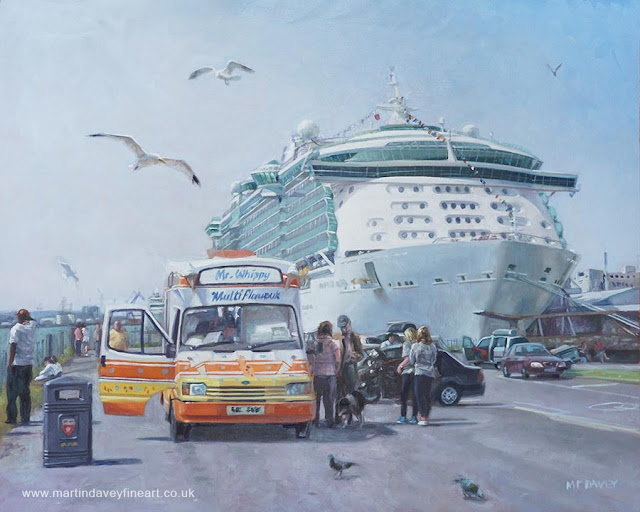 |
| Finished art of the ship docked at Mayflower Park |
 |
| Creation of the Edwardian couple in WIP stages digital illustration |
Once
the drawing has reached a satisfactory start, some rough colour ideas
are then painted in using the same software as seen in the second,
upper right panel. After this stage the time has come to do the
artwork ' correctly' as it needs to be far larger than the tablet can
cope with and more finely detailed. So the file, as PSD layers, is
exported in to a windows desktop machine also running Sketchbook pro,
the file enlarged considerably and the image painted over to a higher
degree, as shown in the 3rd panel.
In the 4th panel can be seen the final image, where there are subtle changes to the composition and some of the elements, like the woman's face and other details. The whole image can be seen in detail on this link.
 |
| digital art of steam punk Edwardian couple escape. |
Created in June 2020 this digital illustration was produced in 'Sketchbook Pro' with final work done in photoshop. It can be seen in greater detail here.
 |
| WIP stages of the horror illustration |
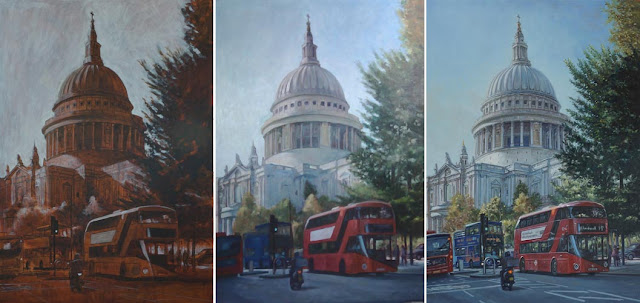 |
| Stages of the oil painting of St Pauls, in central London |
 |
| Completed painting of strollers at Southampton Common art |
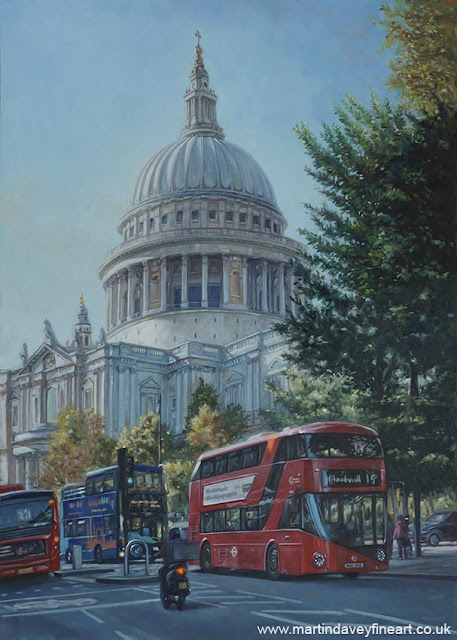 |
| Completed oil painting of St Pauls cathedral, London. |